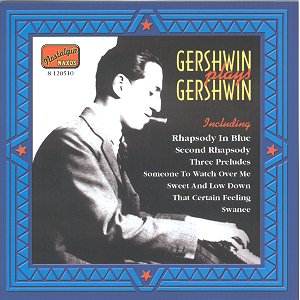George GERSHWIN
Gershwin plays Gershwin (original recordings 1919-1931)
 Naxos Nostalgia 8.120510
* [62:53]
Naxos Nostalgia 8.120510
* [62:53]
Crotchet
AmazonUK
AmazonUS

Swanee, Sweet and Low Down, That Certain Feeling, Looking for a Boy, When
do we Dance?, Do-Do-Do, Someone to Watch Over Me, Clap Yo' Hands, Maybe,
My One and Only, 'S Wonderful - Funny Face, Rhapsody in Blue, Preludes 1-3,
'Andante' from Rhapsody in Blue, Second Rhapsody
Although the subtitle of this album states 'original recordings from 1919-1931'
all but the first track cover the span from 1924-1931. The exception
is the opening 'Swanee', with Gershwin as one quarter of the (Fred) Van Eps
Quartet. One of those songs that always seem to have been around, it was
Gershwin's first major hit, recorded here when it was fresh and brand new.
Inevitably the sound quality of the acoustic 1919 recording makes it sound
ancient.
The next 10 tracks are solo piano transcriptions, Gershwin playing his own
tunes from a series of Columbia recordings made in London and New York between
6 July 1926 and 12 June 1928. The numbers come from the shows Tip Toes,
Oh, Kay! and Funny Face, and demonstrate the composer's great
flair for sophisticated melody within a popular song format. Also from Columbia
and recorded in 1928 is the composer playing the Preludes 1-3, coupled with
a piano transcription of the andante from Rhapsody in Blue.
If these performances tell us anything it is that in the hands of a genuinely
creative and innovative talent, whether the music be popular song, 'classical'
or pseudo-symphonic, genre is really of little concern in the face of beguiling
music-making.
While it is wonderful to be able to hear Gershwin playing these pieces, what
will be really selling the disc is the premiere recording of Rhapsody
in Blue, made with Gershwin at the piano and Paul Whiteman directing
his Concert Orchestra, recorded on 10th June 1924, shortly after
the same forces premiered the work in New York. It comes as quite a shock,
for this Rhapsody is nothing like the work we know. Opening with comically
playful trombones (which had already been consigned to history by the second
recording in 1927) this is a lighter, less artfully self-conscious performance
than the romantic, lonely anthem to the big city now instantly recognisable.
This version sounds rough around the edges, struggling to find a complete
form, and as recorded, lasting just over nine minutes, misses a considerable
amount of the material we now consider essential.
The Second Rhapsody is virtually unknown, and was intended as a sequel
to Rhapsody in Blue. The work was premiered in January 1932 with
Koussevitzky conducting the Boston Symphony and Gershwin at the piano, but
this recording predates that premiere by over seven months, being taken from
a June 26 1931 NBC radio concert with a 55 piece studio orchestra. This 14:35
minute piece is essential listening; Gershwin's melodic flair so in evidence
and combined with various attractive Latin-flavoured devices and colours.
It is a mystery why the work is not better known.
Inevitably the sound is both variable in quality and comparatively poor by
modern standards, nevertheless the solo piano pieces come across with
considerable clarity and are thoroughly listenable. Rhapsody in Blue
itself is more of a struggle and the Second Rhapsody, coming from
a live radio recording is plagued by distortion and weak sound. Nevertheless,
this is still a valuable piece of musical history and a real bargain at Naxos
budget price.
There are more Gershwin performances on "Fascinating Rhythm" Fred Astaire
complete recordings Volume 1 - 1923-1930 (Naxos Nostalgia 8.120501)
Gary S. Dalkin

